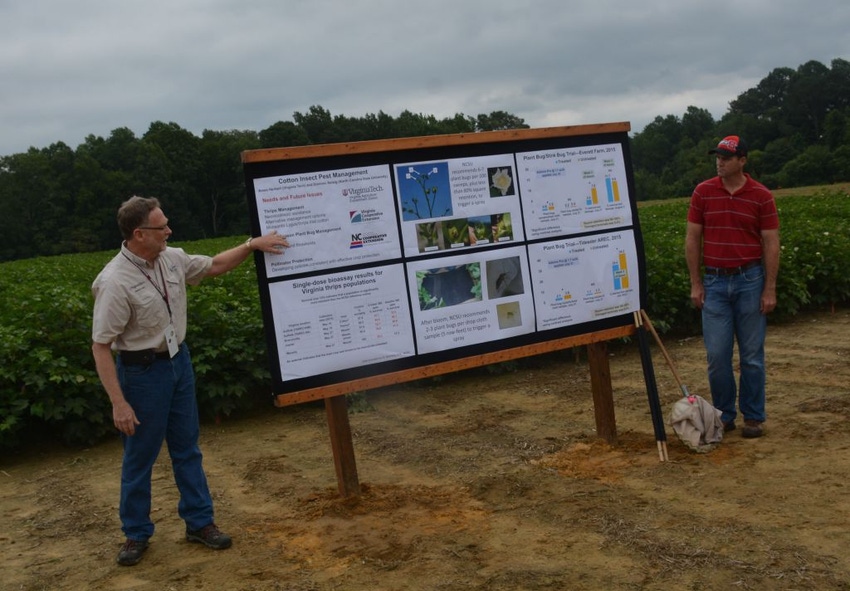
Plant bugs are becoming a bigger and bigger challenge for farmers in Virginia and North Carolina.
At the Virginia-Northeast North Carolina Cotton Field Day held Aug. 11 at Virginia Tech’s Tidewater Agricultural Research and Extension Center, Virginia Tech Entomologist Ames Herbert and Dominic Reisig, North Carolina State University Extension entomologist, outlined some of their plans and strategies for plant bug control in region.
“In the Mid-south they have developed a lot of research on plant bugs because they have had a lot of plant bug pressure. It’s newer for us in the East. We’re seeing it now and we’re seeing it more and we’ve had some heavy hits in Virginia and some heavy hits in North Carolina,” Herbert said the field day.
Herbert said he and Reisig plan to use the plant bug recommendations of Mid-south entomologists and adapt them to Mid-Atlantic states. The recommendations won’t fit Virginia and Carolina exactly, but they provide a good starting point for plant bug control in this region, Herbert added.
For cotton producers, plant bug control does not have a “one size fits all” solution, Herbert stressed. “Every year is going to be different and the climate is going to be different that drives these bugs,” he added. “What you have on your farm can vary a tremendous amount. You have different planting dates, different varieties, different soil types and different amount of rain across your farm. All of that contributes to differences in these bug populations.”
Reisig added that the Mid-south plant bug recommendations are a good starting point for Virginia and North Carolina and the plant bug thresholds in the Mid-south work well in this region. Reisig believes Mid-south entomologists have been a bit over protective with plant bugs, but he said that is a good thing.
“The Mid-south entomologists that have been dealing with plant bugs for a number of years are very concerned for us because they don’t want us to go down the same road that they’ve gone down,” Reisig said. “We can still kill plant bugs with pyretheroids. They cannot. That’s a huge tool that we have in the tool box and we need to preserve that. We don’t need to under spray and we don’t need to over spray.”
Reisig said cotton farmers need both an early season approach to plant bug control and a late season control. In the early season, a sweep net is needed for effective scouting. For late season, sampling should be done with a black drop cloth because the black background better shows plant bugs than a drop cloth with a white background.
In early season, if the sweep net shows eight plant bugs in 100 sweeps, N.C. State recommends a spray. In later season, when the drop cloth is used for scouting, the university recommends a spray if there are two to three plant bugs per five foot sample.
“Divide spray into early mid and late season much like the sampling,” Reisig explained. “We have a difficult time in getting early season trials for plant bugs and that’s an important principle for plant bug management. The reason we have a problem getting early season trials is we’re trying to manage adults. Plant bugs are moving around in the system and those adults can move in hours behind your spray even if you use the most effective chemical so we have a very difficult time getting early season trials in because those adults are migrating into the field.”
N.C. State recommends neonicotinoid class insecticides for early season control, Reisig said.
“Neonicotinoids should help preserve beneficial insects and probably not flare some of the other problems that can be caused by too much insecticide application,” he pointed out. . “We hope that can get you to second, third and fourth week of bloom, the times we want to manage stink bugs. At that time, we can hopefully couple our management of plant bugs and stink bugs together.”
About the Author(s)
You May Also Like






